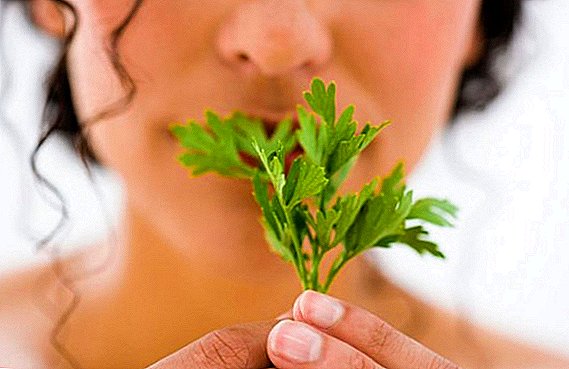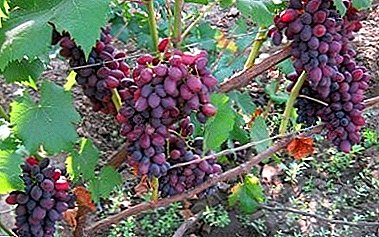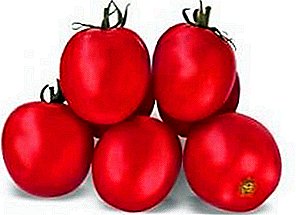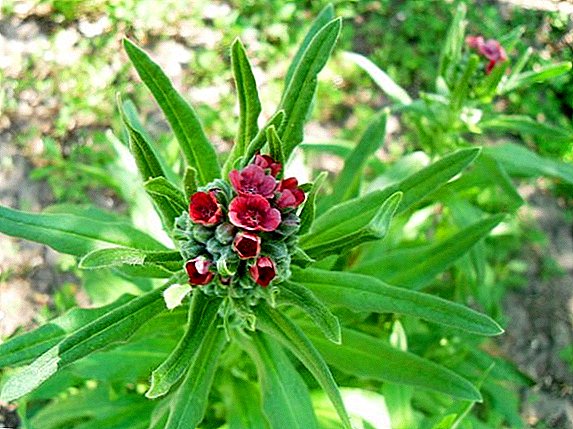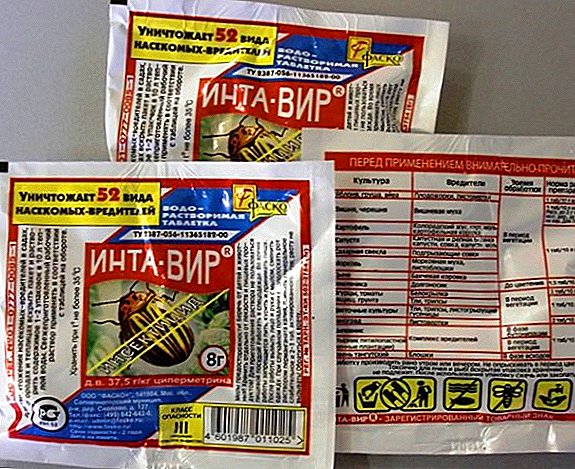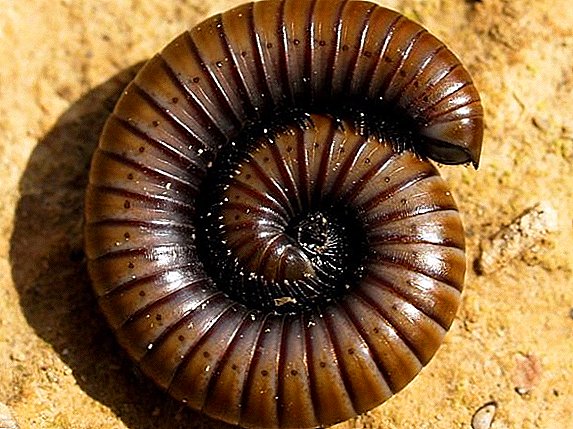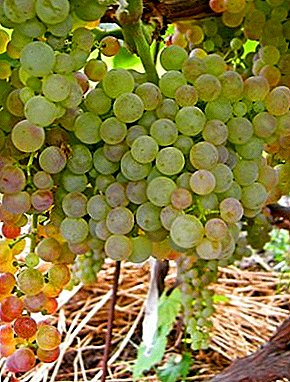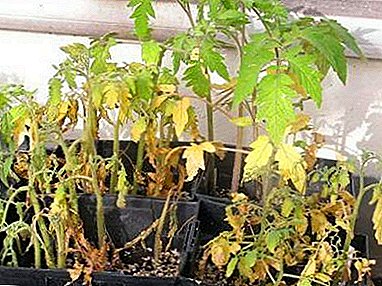
The problem of yellowing the leaves of tomato seedlings can overtake both experienced and novice gardeners.
Yellowing may signal improper care of seedlings, or indicate the presence of fungus.
The main thing is to find the roots of the problem in a timely manner and correct the problem, because otherwise the entire crop is under threat.
In this article we will talk about the reasons why yellowing usually occurs and how to deal with this unpleasant phenomenon.
Common causes
Why do the lower leaves of tomatoes dry, the seedlings do not grow, wither and what to do in this case?
Priming
The abundance of peat in the prepared substrate for sowing seeds can slow down the growth of seedlings and form light yellow shades on the foliage. Also sand and perlite must be in the substrateotherwise, after watering the soil will turn into a heavy lump, which will interfere with the normal development of the roots.
Important. Soil salinization is one of the main causes of yellowing of tomato seedlings.
You can detect a surplus of salt on white and yellow spots on the surface of the earth. Salting occurs from hard water or excess fertilizer.
To solve the problem with the soil will have to transplant seedlings, having previously created an optimal earth mixture, it consists of:
- Washed river sand - 1 part.
- Sodland -2 parts.
- Leaf soil or peat - 1 part.
- Perlite - 1 part.
- Coconut substrate - 1 part.
- Wood ash - 0.5 parts.
Salt soil is treated by cleaning the ground from the surface (3 centimeters will be enough) and irrigation with soft rainwater.
Watering
 Tomato seedling needs a special irrigation regime. The main requirements are:
Tomato seedling needs a special irrigation regime. The main requirements are:
- Infrequent but abundant watering.
- Warm water.
- The optimal time of day for the procedure is morning or evening.
- Water pours under the root, avoiding contact with the leaves.
Seedlings are equally harmful excess fluid and its deficiency. The stagnation of moisture deprives the roots of oxygen, with the result that yellowness is formed on the leaves, the roots rot, and the fruit turns out to be watery in taste. The lack of moisture can be recognized by the twisted and yellow lower leaves of the seedlings, while the top remains green, due to the fact that the plant allocates a resource for the development of new leaves.
Nutrition
Trace elements - a very important factor affecting the health of the plant and seedlings in general. By certain characteristics, it is possible to determine what exactly the seedlings lack and supply it with this.
- Potassium. Its deficiency is expressed in the yellowing of the edges and tips of the leaves, when the veins remain green. For replenishment you can feed the seedlings with potassium sulfate or potassium humate.
- Nitrogen. Its deficiency is visible through the yellowed tips and streaks. Yellowness appears on the lower leaves of the seedlings, while the upper ones decrease in size. The treatment is urea, ammonium nitrate, rotted mullein or chicken droppings.
- Calcium. His absence twists and deforms the leaves. The upper leaves turn yellow, and the lower leaves remain green. Correct the situation can be calcium nitrate.
- Zinc. Its lack makes the plates of the bottom sheets pale yellow, as if they are colorless. The solution will be spraying the seedlings with zinc sulfate.
- Iron. Its deficit in reducing the size of new sheets. The foliage at the top becomes yellow, with dark green protruding veins. You can compensate for the lack of iron chelate in the liquid for watering or spraying the leaves of vitriol.
- Magnesium. Its drawback makes the border around the contour yellow, and the vein leaves green. The addition of magnesium sulfate to the liquid helps.
- Phosphorus. Its lack makes the stem and leaves purple, and the top of the seedlings acquires yellowness. Problems are solved by drawing superphosphate.
- Manganese. Its lack makes the leaves yellow and dries them, which leads to wilting and falling off. To normalize the situation, it is enough to spray the foliage with zinc sulfate.
If there is a lack of several elements, when the foliage of the seedlings becomes yellow-green, and the stem is thin and elongated, you can use complex fertilizer. In order to improve the absorption of fertilizing and prevent burns fertilizer application procedure should be carried out on a wet substrate.
Lighting
 Tomato seedlings love light and react negatively to long, overcast weather, even yellowing.
Tomato seedlings love light and react negatively to long, overcast weather, even yellowing.
To seedlings receive a sufficient dose of lighting, at home it is recommended to put seedlings on the windowsill, located on the sunny side.
In addition, you can get special fitolamps that will help extend the daylight hours. Plants should be in the light for about 12 hours..
An overabundance of light is also harmful, as the plant can burn out. In addition, it is at night that saplings absorb nutrients, and therefore artificial lighting at this time is not needed.
Tight landing
Tomato seedlings do not like cramped conditions. In the absence of space, the roots become bad, and the seedlings begin to languish, which is displayed on the yellowed foliage.
Important. Optimum planting stock density: between rows of tomatoes - at least 5 cm, and between seedlings - 2 cm.
Diseases
Disease can lead to yellowing of the seedlings, as well as to the death of the crop. The most common ones are:
- Fusarium. The disease can be identified by wilting of the lower leaves, and by the yellowness of all other leaves and the top of the seedling. If the plant is not completely affected by yellowness, you can try to save it by transplanting it into clean soil. If the plant is completely spoiled - it remains only to throw it away in order to avoid further spread of the infection. Spraying phytospirin also helps.
- Blackleg. Infectious disease, which is very dangerous for many plants, including tomatoes. Its presence can be seen in the decay of the root collar, yellowing and falling leaves. The plant as a whole becomes sluggish and falls. There is no cure for the black leg, the main thing is to have time to destroy the infected seedlings before transferring the bacteria to healthy ones.
- Rot. Excessive moisture and lack of heat lead to the appearance of rot. It can be diagnosed by yellowing, falling off and rotting of the plants. Sick seedlings must be uprooted and discarded, and healthy ones should be transplanted.
Nuances
Sometimes a problem can occur under certain circumstances and actions, for example:
 After transplant. No matter how careful the transplant is, the seedlings are still stressed and the lower row of leaves will be yellowish during the adaptation period. Acclimatization will happen soon.
After transplant. No matter how careful the transplant is, the seedlings are still stressed and the lower row of leaves will be yellowish during the adaptation period. Acclimatization will happen soon.- On the windowsill. If the yellowness manifested itself suddenly, without any additional manipulations by the gardener, then the case may be in burns received from the sun or a draft. Otherwise, it is worth looking more closely, as the case may be in sickness or poor nutrition.
- After picking. Not all gardeners know why the tomato seedlings turn yellow after picking. For seedlings, it is natural to react with the appearance of yellowness to this procedure, after 7-10 days everything will automatically return to normal. In order to calm you can spray the seedlings "Epinom".
- Landing in the ground. Saplings important to adapt to environmental conditions. Too many factors influence it - the quality of the soil, the temperature, the insufficiently heated land, and so on. Pre-hardening of seedlings will help to avoid problems. To do this, you can make it into the shadows, each time increasing the duration of being in the shadows, and then return it to the sun.
- Open ground. In this case, yellowing may occur from a nutrient deficiency in the soil or the presence of fungi. Top dressing and disinfection of the soil will help in this situation, if there is a need for these measures.
- Yellow leaves of seedlings turn yellow. This can occur for various reasons. After transplantation (in the case of proper execution) yellowing will pass by itself, if it is a shortage of nitrogen, then it is necessary to provide seedlings with additional nutrition. Also, the effect of yellowing of the lower leaves can be observed from a high or low temperature, or insufficient watering.
In general, tomato seedlings need an optimal ratio of light, temperature, moisture and nutritive soil. The presence of these conditions will prevent the occurrence of risks.


 After transplant. No matter how careful the transplant is, the seedlings are still stressed and the lower row of leaves will be yellowish during the adaptation period. Acclimatization will happen soon.
After transplant. No matter how careful the transplant is, the seedlings are still stressed and the lower row of leaves will be yellowish during the adaptation period. Acclimatization will happen soon.